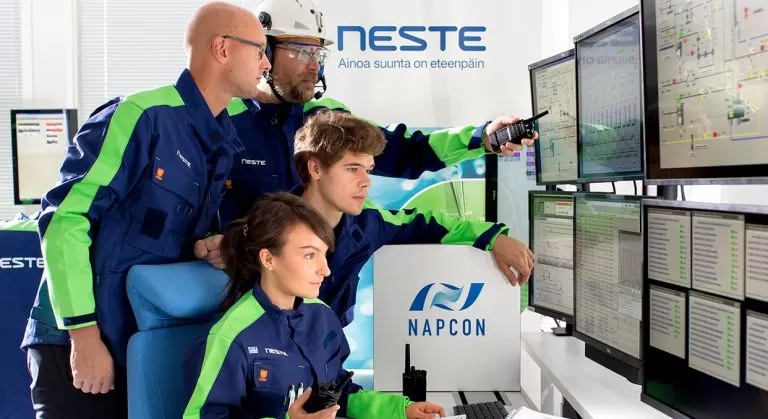Digital Disruption in the Manufacturing Industry

Share this blog
Far from being just another buzzword, digital disruption is a very real concern for every single sector. As we stand on the cusp of Industry 4.0, its consequences have never been more profound.
So, what does digital disruption entail? Gartner defines digital disruption broadly as, “an effect that changes the fundamental expectations and behaviors in a culture, market, industry or process that is caused by, or expressed through, digital capabilities, channels or assets.” In short, it is the fundamental altering of a given sector by virtue of digital techniques and technologies.
Digital disruptions in manufacturing
Manufacturing has been no stranger to digital innovations, many of which have caused individual digital disruptions as technology has permeated the sector for over 50 years. While the first numerically controlled machines may have lacked interfaces familiar to us now, they still relied on digital technology. As technology has matured, more and more of the manufacturing process has become digitized, and ever-more connected. Each innovation has brought incremental productivity and efficiency improvements to manufacturing, forcing traditionalists to embrace new technologies, techniques and skills.
The current state of digital manufacturing
The scale of change for digital technology is far greater than it used to be. Manufacturing is entering the Fourth Industrial Revolution—a near-simultaneous emergence of several world-shaking technologies at once: the industrial internet of things (IIoT), augmented reality (AR), and cloud technology. Each would cause a digital disruption on its own, so together creates a full-scale revolution.
For example, organizations are using IoT-enabled remote machine monitoring, manufacturers to achieve staggering levels of machine uptime as predictive analytics alert technicians to potential faults, so they can reduce unplanned downtime. Remote monitoring provides accessible, real-time insights to end-user customers that optimizes value and increases satisfaction rates.
Augmented reality provides another means for manufacturers to use technology to surge ahead of competitors through a revolutionized workforce. AR glasses overlay precise 2D and 3D guidance onto the machinery in front of them, so that workers can easily learn complex new processes and procedures while on the floor. AR helps to train workers on new skills and take their performance to the next level without having to slow down production.
There is incremental benefit outside of OEE and productivity gains that organizations can discover by leveraging the IoT and AR technologies. Check out PTC’s Digital Manufacturing Solutions to learn how to stay ahead of the digital disruption in manufacturing and unlock a business transformation.
The future of digital disruption in manufacturing
Analysts predict that in five to ten years the way manufacturing is conducted will be unrecognizable. As manufacturers become more familiar with Industry 4.0 technology, they will begin to wield it in new and innovative ways, creating fundamental structural changes. The biggest changes will be rooted in the seamless connection of every stage of the production process.
Credits: PTC Inc.
Get in Touch
Related Blogs

Balancing Feature Development with Platform Enhancement: A Strategic Imperative

Managing IT Costs Effectively: A Strategic Approach to Balancing Growth and Efficiency

The Hidden Complexity of Scaling Cloud Operations: What Most Strategies Miss

Managing Technical Debt: Balancing Innovation with Sustainability

Maintaining Development Velocity While Ensuring Quality: The Balancing Act

Navigating Financial Strategies for Global Expansion in SaaS

Precision in Complexity: Redefining Capital Allocation for Sustainable Growth

Beyond Silos: Rethinking Cross-Functional Collaboration for Scalable Product Development

Simplifying Global Expansion: The Power of One Strategic Partner

The Unfinished Symphony of Digital Transformation: From Strategy to Execution

Beyond Traditional Process Intelligence: Integrating Emerging Technologies for a Competitive Edge

Tekninen Velka – Kuinka Se Haittaa Kasvua ja Miten Sen Saa Hallintaan?

A Deep Dive into Product Engineering: Process, Roles, and Best Practices

What is Cyber Resilience? An In-Depth Guide

A Comprehensive Guide to Cloud Transformation

24 Emerging Software Development Trends Transforming 2024

Is AI Secure? Addressing Cybersecurity Risks with AI

How Is Cloud Computing Transforming Sustainable Healthcare in the Nordics?

Gateway Digital is Neste Napcon’s Partner in Creating Digital Learning Environments for the Process Industry

Tuotekehitysyhteistyön avulla joustavuutta ja kustannushyötyjä – Case School Day

Petteri paju vahvistamaan Gatewayn myyntiä

Top 6 Trends Transforming Logistics and Supply Chain in 2020

Why is it Important to Hire the Right Employees to Grow your Business?

Miten IT-alan ammattilaisten vaje näkyy Suomessa?

How Can Emerging Technology Facilitate Faster Start-up Growth?

The Need For Smart Logistic Planning: Takeaways From The Suez Canal Crisis

Gateway Digital AS and Retailtech strengthen their strategic partnership

Gateway Digital and Digitate enters strategic partnership

The DACH cloud computing industry in 2021 and beyond

Why Germany is home to the most innovative Tech Startups

Dataplattform för att identifiera bilreservdelar vinner pris inom hållbarhet

AWS vs GCP vs Microsoft Azure: Everything you need to know

Ensuring a higher ROI on your Technology Investment: Here’s How

Why the future of Startups & Scaleups depends on Technology Partner

Infographic: Elevate your Business with Augmented Supply Chain

Infographic: Empowering the Digital Healthcare Ecosystem

Infographic: Why Strategic Technology Partnerships are imperative for ISVs

Infographic: How PES is Empowering the Digital Healthcare landscape

Impact of Covid 19 on the Automotive Industry

How COVID-19 is Changing the Face of Digital Healthcare

Transform your Digital Journey with Strategic Technology Partnerships

Succeed your Business with Partnerships – The New Normal for Fintech!

Supply Chain Focus Areas to Mitigate COVID-19 Disruptions

How Digital Transformation is Redefining the Healthcare Industry

Benefits of Digitising Your Product Development Process

How to Develop a New Product (From Concept to Market)

How Automotive and Technology Experts See the Future of Connected Vehicles through Future Tech 5G Service

Industry Digitization will be Top Opportunity for 5G business solutions

5G Products & Solutions in 2023 & Beyond– What Should we expect from 5g network software?

Everything You Need to Know About 5G network as a service

Cloud Companies Chase Future in Cybersecurity ‘Wild West’

The Future of Lawyers: Legal Tech, AI, Big Data And Online Courts

Why Covid-19 Could Expedite the Role of RegTech in Finance

3 Elements For Success With Mobility As A Service In Our Cities

Digitalization is Upending Global Logistics

Mastering the Duality of Digital: How Companies Withstand Disruption

iGaming Technology Trends to Watch

73% Growth and Instant Blockbusters: How Online Gaming Industry Is Blowing Up During the Pandemic

The 5 Biggest Cybersecurity Trends In 2020 Everyone Should Know About

Why Cybersecurity Is Really A Business Problem

Technological Disruption or Next Industrial Revolution?

What Will Be The Future Success Of Fashion Retail In The Digital Age

The Banking Industry Is Spending Wildly on the Latest Tech

Disruption in Manufacturing: Managing Unexpected Risks

5 Manufacturing Tech Trends Poised To Disrupt Your Business

Future Factory: How Technology Is Transforming Manufacturing

Five Ways the Internet of Things is Transforming Businesses Today

The Mobility-as-a-Service Market will Register a CAGR of Over 35% by 2023

3 Ways Every Company Should Prepare For The Internet Of Things

The Three Stages Of Cloud Transformation: Application, Network, Security

Cloud Computing Seen as Tech Haven Amid Pandemic Uncertainty

How Multi-Cloud and Digital Transformation Fit Together

8 Ways Cloud Is Transforming Business

Mixed Reality Finds Its Niche in Industrial and Business Applications

Virtual Reality is Making Marketing and Training More Effective for Businesses

What Leaders Need To Know About Augmented Reality

The 5 Biggest Virtual And Augmented Reality Trends In 2020 Everyone Should Know About

DevOps Model: The Role of Quality Assurance Redefined

Quality Engineering Has DevOps and Agile in the Driving Seat

How QA Can Support Businesses in the Journey of Digital Transformation

Quality Assurance Is Critical In Software Development And Increasingly Automated

Resolving Challenges of Auto ISVs with Fruitful Technology Partnerships

Resolve Fleet Management Challenges with Innovative Digital Automotive Solutions

Top 3 Factors Impacting Customer Satisfaction of Modern Car Buyers

Fleet Telematics Solution: Driving Great Business for Automotive Ecosystems

Top Supply Chain Tech Trends

How Artificial Intelligence Benefits Logistics and Supply Chain Management

Fleet Management in 2024 & Beyond: What Does the Future Look Like?

How to Identify a Trusted online iGaming Solutions Provider?

Mastering Enterprise Digital Transformation: Building Blocks of a Successful Strategy

Center of Excellence: Building Intelligent Solutions for the Enterprises of Tomorrow

Want to Succeed in Digital Transformation? Choose the Right Technology Partner

Customer Satisfaction in an Ever-Evolving iGaming Industry

How to Tackle Security Risks in Digital Transformation

The State of Legal Tech: What Every Legal Business Must Know

Legal Technology in 2020 and Beyond

Want to Succeed in Digital Transformation? Choose the Right Technology Partner

Fulfilling Customer Experiences in the Digital Era: How to Go About It

The Impact of COVID-19 on Digital Transformation

Taking the Pain Out of Application Modernization
INDUSTRIES
PLATFORMS
SERVICES
CONSULTING
- AlvariumTM - Design Led ConsultingOpens a new window
- Digital Marketing Services
- Automotive Aftermarket
- Digital Logistics
- Remote Engineering
